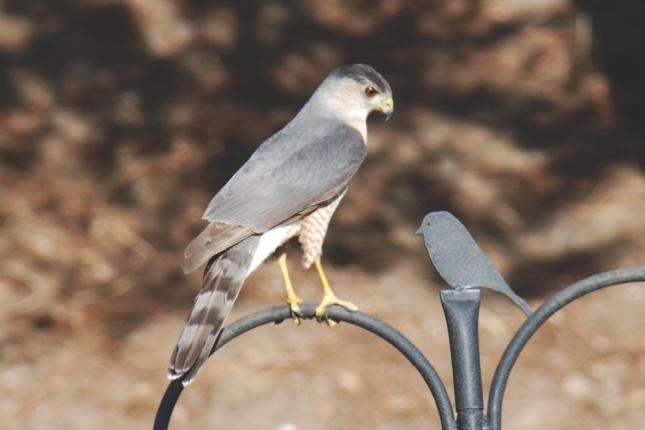Hawks Near Your Feeders

“There’s a hawk in my yard!”
That’s a pretty common occurrence, with hawks being a natural part of the ecosystem. Of course, few of us want to see them dining on the other birds we are attracting to our yards, so here are a few tips to give your other birds an advantage:
• Ideally, position bird feeders on poles 10-15’ from trees or bushes. At that distance, birds can watch for approaching predators (including both hawks and cats) from all directions, but still escape into cover when needed. A feeder too far away isn’t good, but on the flip side, a feeder right next to trees makes it too easy for a hawk to hide in the branches and ambush the birds as they land on the feeder. 10-15’ is the right balance that seems to minimize the hawks’ success rate.
• Plant many types of vegetation (trees, bushes, vines, tall grasses, etc) all around the perimeter of your yard to provide more cover for birds.
• Place feeders in multiple spots in your yard so birds aren’t all concentrated together. Ideally, even on different sides of your house. If a predator is spotted at one part of the yard, birds may be ale to fly around to another spot and feed out of sight.
• Recognize that hawks will be successful every now and then. If this occurs, avoid the temptation to run out and scare the hawk away. Doing so won’t help the bird that has been caught, but would force the hawk to hunt again sooner than it would otherwise, putting other birds at peril. Just close your blinds and wait it out.
• Thankfully, hunting in any given yard tends to run in short cycles. Hawks prey on weaker or less observant birds, meaning the healthy, wiser birds begin to lay low for a bit and after a few days to weeks, the hunting gets hard enough that the hawk moves on down the road. Until then, try to appreciate the beauty of the hawks themselves as they fulfill their niche in nature's plan.

